“Reunion” – Film Review from Australia’s 17th Japanese Film Festival
Australia’s 17th Japanese Film Festival is soon embarking on its last city tour in Melbourne, the capital of the southern state of Victoria, after being shown around Australia in the first ever national film festival administered by the Japan Foundation. Eden Law (Fukushima-ken ALT 2010-2011, current JETAA NSW committee member) got to see some of what’s on offer during its recent run in Sydney. This one’s for you, Melbournites! Don’t say we don’t do anything for you south of the border.
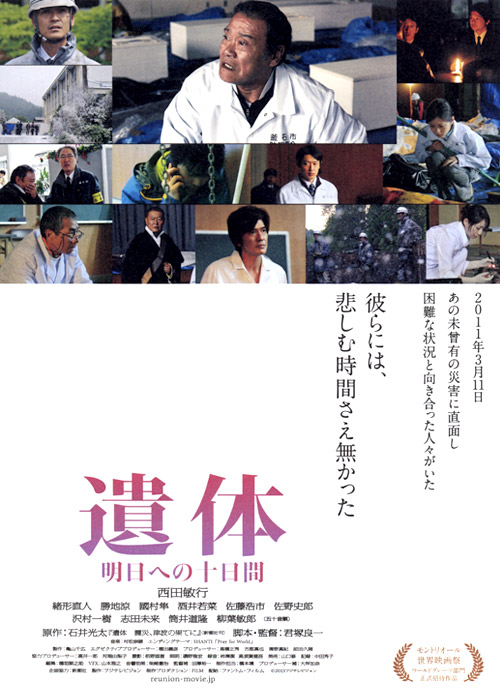
If you can’t feel anything watching this, you are probably dead inside.
It has been almost three years since the disaster that devastated the north of Japan. There have since been a handful of films on the event, on the nation and it’s people as they resolutely look forward to “revival” and reconstruction. However, few of those films, I suspect, would have dealt quite so starkly and closely on the subject of death quite like “Reunion”.
“Reunion” is a dramatization of Itai: Shinsai, Tsunami no Hate ni (遺体―震災、津波の果てに?, “The Bodies at the End of the Earthquake and Tsunami”), a reportage of the events by Kota Ishii in the days immediately following the earthquake and tsunami of March 11. A brief snapshot of the normal, mundane lives around town in the beginning, contrasts sharply the aftermath, showing how unprepared and ill-equipped the small town’s public servants were, as bodies kept coming into the temporary morgue set up in the old high school gymnasium, and distraught relatives plead for information and support. Horrified by the disorganization and haphazard treatment of the dead, Aiba (played by Toshiyuki Nishida), a retired funeral home director, volunteers to oversee the proper administration of the morgue. He shows the exhausted and numbed workers how to massage limbs stiffened by rigor mortis until they became pliant again for proper positioning, and how to counsel and deal with the grieving and traumatized people who come to identify the deceased. And slowly, people carry on with their jobs, because there is very little other choice.
This will be the most heart-breaking film you’ll ever watch this year. I’ve never cried at the movies before (if there’s anybody watching), but looks like there’s the first time for everything. While the subject matter itself is undeniably powerful and emotional, “Reunion” is actually quite simple, a recounting of the events and the personal tragedies of those who survived. Music is used sparingly in this film, the silence heightening the solemnity and noises that included the constant squelching of the mud-logged boots and the sobs of the bereaved, background sounds as described in the book. Director Ryoichi Kimizuka makes sure that the deceased is an all-pervasive presence, as the cast of characters work with them and around them, uncovering their blackened swollen faces, identifying them and saying prayers for their souls. Thanks to Aiba’s character, not only are the workers brought around to empathise with the dead, as their names and personal stories are revealed, but the audience also becomes involved. Little wonder then, that at many events where this film has been screened, audiences have been emotionally devastated.
In this film where multiple stories and tragedies play out, the cast work marvellously well together. There are very little histrionics or hysteria, just numbed helplessness, as many at first wander confusedly about before being given direction by Aiba. Performances are muted and restrained, which make the break-down moments even more heart-wrenching, for everyone has their trigger, be it the discovery of a loved one’s body while carrying out work, or the tragedy of a young child, unclaimed by any surviving relatives. There are no questions of morality, no “why did this happen to us”, soul-searching, condemnation or religious debate to be had that can be adequate. From Aiba’s point of view however, the answer is to never forget one’s humanity, which can be even more precious than food, in order to survive the unrelenting horror and sorrow of the situation. And that in the end, ultimately provides a glimmer of positivity in this film, as well as in life.
Reunion (Itai: Shinsai, Tsunami no Hate ni) by Ryoichi Kimizuka, released in Japan February 23 2013, starring Toshiyuki Nishida, Naoto Ogata, Ryo Katsuji, Jun Kunimura, Wakana Sakai, Tsuneo Aiba, Kenichi Domon, Yuta Oikawa, Yoshito Shibata, Takae Oshita, Koichi Sato, Shiro Sano, Ikki Sawamura, Mirai Shida, Michitaka Tsutsui, Michio Shimoizumi, Takeshi Yamaguchi, Nobutsugu Matsuda, Yuko Terui, Daisuke Hiraga, Toshiro Yanagiba
“Brain Man” – Film Review from Australia’s Japanese Film Festival
Australia’s 17th Japanese Film Festival is soon embarking on its last city tour in Melbourne, the capital of the southern state of Victoria, after being shown around Australia in the first ever national film festival administered by the Japan Foundation. Eden Law (Fukushima-ken ALT 2010-2011, current JETAA NSW committee member) got to see some of what’s on offer during its recent run in Sydney. This one’s for you, Melbournites! Don’t say we don’t do anything for you south of the border.
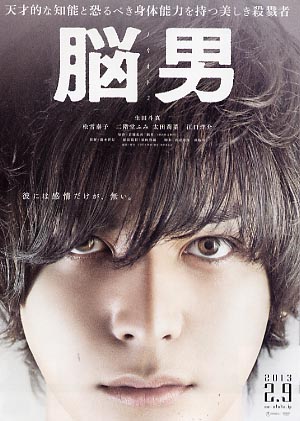
Doumo arigatou Mr Roboto
At times graphically brutal and sadistic, “Brain Man” moves at a brisk pace, frequently keeping the audience off-balance with unsettling scenes and stylistic ideas that are reminiscent of other films in the genre. An adaptation of the novel “No Otoko” by Urio Shudo, the novel itself won the 2000 Edogawa Rampo Award for newcomers to crime fiction. In it, a series of sadistic murders and explosions pressures the police lead by Detective Chaya (Yosuke Eguchi, who must be channelling every crusty, grouchy detective character ever to exist in film) to find the culprits responsible, and soon enough Ichiro (Toma Ikuta) is apprehended as the prime suspect. However, things are rather decidedly odd about Ichiro, who is more like a robot than a human, going like clockwork to… go, unable to feel pain or emotion. Although in peak physical condition (via an establishing shot as the camera lingers over Toma’s skinny yet hard-bodied torso, which is itself inhumanly bereft of fat), he is clearly a special psychiatric case, which is where Dr Washiya (Yasuko Matsuyuki), a brilliant psychiatrist, comes in to help with police investigation. Although like other characters in the film, she herself carries a trauma, that fuels her determination to investigate and uncover the truth about Ichiro, and ultimately the case.
This film calls for a certain suspension of disbelief – probably more than usual, with the number of implausibilities it has. This is not a film that is completely grounded in reality, even given the premise of a serial-bomber-Saw-wannabe and a man-bot. However, that’s not to say it’s done badly. Director Tomoyuki Takimoto excels at creating a tense, unsettling atmosphere, typically using lots of dark cold colours that’s grim and claustrophobic, even in the day scenes. There are unexpected shocks punctuating the film at a brisk pace, creating a sense of dangerous unpredictability for the characters. Takimoto doesn’t shy away from being graphic either, what with body parts being ripped, stabbed, shredded or sliced merrily in some form or another, in sadistically creative ways. Some of the characters and baddies are suitably over the top (especially Fumi Nikaido and Rina Ohta as Noriko and Yuria, in deliciously scenery-chewing performances), though are a little obscure in their motivation. But whatever man, they’re totes cray-cray – who can understand why they do the things they do.
But that sort of unreality element can work against it, especially when the film, in the form of Dr Washiya, seems to be exploring more serious and unexpectedly philosophical issues: can a person be rehabilitated, or their basic nature changed? In the beginning of the film, Dr Washiya advocates a new form of “narrative” therapy to habilitate hardened criminals, contrary to the accepted methods of the establishment. It’s a theme that surfaces once in a while throughout the film, although largely overwhelmed by the more exciting and visceral violence and terror. But during those moments, Matsuyuki (as the doctor) does really well in giving her character the right mix of toughness and vulnerability, and her interaction with a “cured” patient, brings a totally different kind of disturbing creepiness thanks in no small part to Shota Sometani who plays Shimura, the patient in question. But these differences seem out of place in a film that’s usually more thrills and spills, in a world where a grizzled no-nonsense detective has long hair and the living coin-operated boy somehow has access to a great hair stylist and chic clothes.
However, as mentioned, “Brain Man” is still done well and is highly enjoyable to watch, especially if you’re a fan of the thriller/crime/mystery genre. As Ichiro, Toma Ikuta’s highly restrained acting, communicating only through subtle body language and stares, is quite absorbing. And “Brain Man” manages to deliver right to the end, as a final emotional shock is revealed.
PS: Bonus points for the ending credit song: “21st Century Schizoid Man” by King Crimson!
Brain Man (No Otoko) by Tomoyuki Takimoto, released in Japan February 9 2013, starring Toma Ikuta, Yasuko Matsuyuki, Yosuke Iguchi, Fumi Nikaido and Rina Ohta.
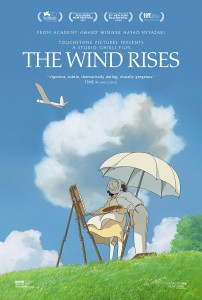
“The Wind Rises is a combination of everything that makes Studio Ghibli as we know it today. It also adds several new elements which make this film dynamic and, some say, controversial.” (Touchstone Pictures)
By Alexis Agliano Sanborn (Shimane-ken, 2009-11) for JQ magazine. Alexis is a graduate of Harvard University’s Regional Studies—East Asia (RSEA) program, and currently works as an executive assistant at Asia Society in New York City.
Written and directed by Hayao Miyazaki, The Wind Rises is like no Studio Ghibli movie I have ever seen. No. Wait. It’s like every Ghibli movie I have ever seen. You want fantasy? You got it. You want airships à la Castle in the Sky or Nausicaä of the Valley of the Wind? You got it. You want deliciously portrayed food? You want nostalgic scenery from bygone days of Tokyo or picturesque European towns? You got that, too. The Wind Rises is a combination of everything that makes Ghibli as we know it today. It also adds several new elements which make this film dynamic and, some say, controversial.
One of the most differentiating factors is that The Wind Rises is the only full-length feature to focus on an actual historical figure—Jiro Horikoshi, the designer of the Mitsubishi A5M, a fighter aircraft of World War II. Granted, Miyazaki used his artistic license to embellish the narrative—but he does that only to make things more beautiful and fantastical. (And that’s why we love Miyazaki, right?)
Watching The Wind Rises, you feel repeatedly—and indeed the entire plot more or less focuses on—Japan’s desperation to achieve modernity according to “Western standards.” But modernization was not a smooth road, and Miyazaki makes that message clear. Despite the beautiful veneer, the crux of this film lies in the frustration of a country and its people. Economic deflation, poverty, and limited resources repeatedly arise as roadblocks. (This may explain part of the reason for its amazing popularity in Japan. Frustrations, impatience and desperation exist within every generation.) Yet, as Jiro is reminded, even with setbacks and disappointments, one must live on and progress despite it all.
JQ Magazine: Book Review – ‘Dreams of Love, Etc.’ from ‘Monkey Business Volume 3’
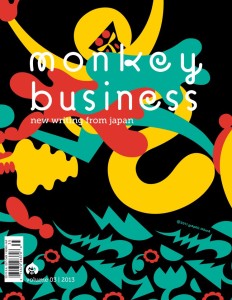
“Most striking about this piece is how astute Kawakami is in capturing not only the loneliness and boredom of daily life, but the paradox of how absurd life is and how, ultimately, it’s also really no big deal.” (A Public Space)
By Sharona Moskowitz (Fukuoka-ken, 2000-01) for JQ magazine. Sharona is interested in fresh, new voices in fiction and creative nonfiction.
In the latest issue of contemporary Japanese literature anthology Monkey Business Volume 3, Japanese novelist Mieko Kawakami writes of roses, post-earthquake malaise and a friendship that never quite consummates.
We first encounter the narrator, who inexplicably calls herself Bianca, as she stands on her porch tending to her bed of roses.
By her own admission, Bianca’s days are filled with nothing—“I don’t work. I’m not pregnant. I don’t watch TV. I don’t read books. Come to think of it, I do absolutely nothing.” What she is, however, is a wife—a loaded title for a Japanese woman with its implications of duty and decorum. Yet she wants more—much more. What exactly, she isn’t quite sure.
Stuck in the doldrums of her daily existence, she thinks and rethinks the simplest decisions, her inner monologue playing out like T.S. Eliot’s “The Love Song of J. Alfred Prufrock.” (“Shall I part my hair behind? Do I dare to eat a peach?”) What little volition she has is spent on tending to her plants, a hobby she developed after the earthquake, perhaps as an outlet for her nurturing tendencies, or, more likely, as a reminder that life was returning to normal after the shaker and its ensuing chaos.
JQ Magazine: Book Review – ‘Three Scenarios in Which Hana Sasaki Grows a Tail’
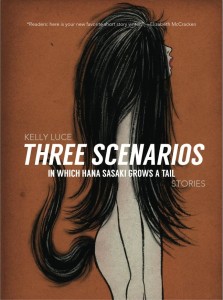
JET alum Kelly Luce’s first published collection of fiction, Three Scenarios often utilizes magic realism to tell stories that take place in Nippon. (A Strange Object)
By Rashaad Jorden (Yamagata-ken, 2008-10) for JQ magazine. A former head of the JETAA Philadelphia Sub-Chapter, Rashaad currently studies responsible tourism management at Leeds Metropolitan University. For more on his life in the UK and enthusiasm for taiko drumming, visit his blog at www.gettingpounded.wordpress.com.
As mysterious as Japan seems to be, there are numerous occurrences in the country that leave you amazed.
Enter Kelly Luce (Kawasaki/Tokushima-ken, 2002-04). The JET Program alum’s first published collection of fiction, Three Scenarios in Which Hana Sasaki Grows a Tail (which is also the title of one of Luce’s stories) often utilizes magic realism to tell stories that take place in Nippon.
Three Scenarios contains ten stories and the first one, titled “Ms. Yamada’s Toaster” (which previously appeared in the anthology Tomo), tells the tale of a toaster that can predict one’s death (the toaster even predicted the death of Ms. Yamada’s husband by popping out a piece of bread three days before he suffered a heart attack). In other stories in Three Scenarios, a teenage girl disappears during karaoke and a stone is haunted by a demon.
While there may be times in Luce’s stories that Japan may seem inconsequential, the “it could only happen in Japan” moments make her stories came alive. For example, in “The Blue Demon of Ikumi,” a foreigner woman who was considered a demon because a child died under her care is set to be executed (she eventually escapes). In “Wisher,” people make seasonal wishes at a fountain’s stone steps, such as students and parents praying before entrance exams in autumn and during summer for travel. And in the above-mentioned “Ms. Yamada’s Toaster,” some villagers wish to make the toaster a deity.
JQ Magazine: Book Review – ‘Gadget Girl: The Art of Being Invisible’
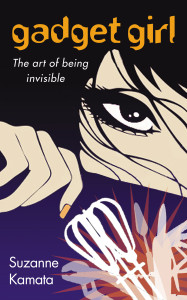
“As Gadget Girl is geared toward young adults (or more specifically, teenage girls), it is an easy read. But you get the sense that because of its diverse set of characters, it would make a good TV drama.” (GemmaMedia)
By Rashaad Jorden (Yamagata-ken, 2008-2010) for JQ magazine. Rashaad worked at four elementary schools and three junior high schools on JET, and taught a weekly conversion class in Haguro (his village) to adults. He completed the Tokyo Marathon in 2010, and was also a member of a taiko group in Haguro.
Sometimes, we’re just trying to find out where we belong.
That’s certainly the case with Aiko Cassidy, the teenage protagonist of JET Program alum Suzanne Kamata (Tokushima-ken, 1988-1990)’s latest novel, Gadget Girl: The Art of Being Invisible. The 15-year-old daughter of a renowned sculptor, Aiko wants to develop her own identity, instead of being known as Laina Cassidy’s muse and suffering from a disability (cerebral palsy). Aiko has been secretly working on manga titled Gadget Girl, and she dreams of becoming a world famous manga artist—which would enable her to visit her father in Japan.
But instead of heading to the Land of the Rising Sun, Aiko is off to France for several days, as Laina has won the grand prize at the prestigious Prix de Paris. Although she’s still receiving the “Laina Cassidy’s muse” treatment, the City of Light does open up a new world for Aiko. For one, she develops a crush on a waiter named Hervé at the café she frequents. Aiko is also introduced to the spot where he parents met but more importantly, she learns the reason why her father is absent from her life.
Inspired by the movie The Song of Bernadette, Aiko and Laina head to Lourdes, where Aiko dreams of being cured. Instead, she hears a woman whisper “Forgive,” and Aiko uses that as a call to repair broken relationships in her life.
JQ Magazine: Book Review – ‘The Accidental Office Lady: An American Woman in Corporate Japan’
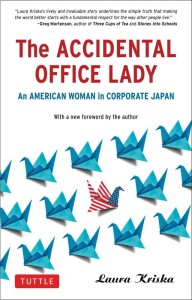
“If you are going to Japan soon, live there now, or have lived there already, this book is a survivor’s guide and tool for reflection and growth. It can help the reader better understand what to do, and what not to do.” (Tuttle)
By Lana Kitcher (Yamanashi-ken, 2010-12) for JQ magazine. Lana is the business development associate for Bridges to Japan and enjoys working as a freelance writer for a number of online publications. To read more about Lana’s adventures in Japan, visit her blog at Kitcher’s Café.
Laura Kriska’s experience as recounted in The Accidental Office Lady parallels in many ways what we as JET participants go through when we temporarily leave our lives and routines at home to pursue the “exotic” and uncertain terrain of a new culture.
Based on Kriska’s background and education, she was offered a two-year position at Honda Motor Company headquarters in Tokyo, being the first American woman to do so. She arrived in Japan equipped with her new business attire and a mind full of expectations and dreams about how the next two years of her life in Tokyo would unfold. She was soon instructed to join the secretariat—coordinating schedules and serving tea to managers in her new, polyester uniform.
Through the course of the book we get to see Kriska transform from a newly minted grad into a successful member of Japanese society. She starts out frustrated by her new environment and deeply disappointed that her job is not all that she hoped it would be. As the book progresses, you start to see that she is losing her childish tendencies to fight back, and eloquently navigating the culture with words and mannerisms instead of outbursts and small rebellions. She takes on more responsibility and in the end is able to create lasting change at Honda with a new employee manual in English and the elimination of the mandatory uniform rule.
JQ Magazine: DVD Review – ‘From Up on Poppy Hill’
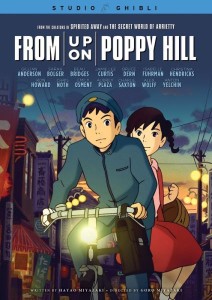
“Studio Ghibli films are known for their fantastical animation and surrealistic landscapes. However, Poppy Hill lacks one other crucial element common to Ghibili films: an emotional depth of feeling.” (GKIDS)
By Lyle Sylvander (Yokohama-shi, 2001-02) for JQ magazine. Lyle is entering a master’s program at the School of International and Public Affairs at Columbia University (MIA 2013) and has been writing for the JET Alumni Association since 2004. He is also the goalkeeper for FC Japan, a New York City-based soccer team.
From Up on Poppy Hill is the latest film to be released from Japan’s famed Studio Ghibli. Unlike its more prominent titles, this one is not directed by studio founder Hayao Miyazaki (Spirited Away, Howl’s Moving Castle) but rather by his son Goro Miyazaki. The father did, however, co-write the script (with Keiko Niwa), which was adapted from a manga published in the 1980s. Goro’s first film, Tales from Earthsea, was a commercial hit but received a very negative reception, even receiving “Worst Director” and “Worst Picture” designations from the Bunshun Raspberry Awards, given annually to the worst in cinema by the Bungeishunju Publishing Company. From Up on Poppy Hill received a much better reception (although many reviews were mixed) and became the highest grossing Japanese film of 2011 and won the 2012 Japan Academy Prize for Animation of the Year.
The story takes place in Yokohama in 1963, a pivotal point in Japan’s history as the country was preparing for the 1964 Tokyo Olympics. The nation was on the economic upswing and the Olympics were meant to showcase the “new” Japan as it pushed its postwar ruin firmly into the past. Within this context, Poppy Hill tells two stories, both of which deal with historical consciousness. The first concerns a high school student named Umi, who lives and works in her family’s boarding house. Her father was lost at sea during the Korean War and Umi flies nautical flags daily from her house in order to wish peace upon all sailors. The second story concerns a clubhouse (named the Latin Quarter), which has been slated for demolition to make way for an Olympics-related building. The building is adjacent to Umi’s high school and she meets Shun, the leader of the clubhouse, who also happens to have been decoding her nautical flags each morning. Umi leads an effort to clean up the clubhouse and soon starts to fall in love with Shun.
JQ Magazine: Book Review – ‘Pink Globalization: Hello Kitty’s Trek Across the Pacific’

“Pink Globalization is a culmination of over ten years of Yano’s fieldwork and research on the international ubiquity of Hello Kitty as an example of Japan’s actions as a tastemaker in global kawaii.” (Duke University Press)
By Jessica Sattell (Fukuoka-ken, 2007-08) for JQ magazine. Jessica is a freelance writer and a graduate student in arts journalism. She readily admits that while she is an avid Hello Kitty fan, she is always going to like Chococat more.
For many, young and old, female and male, Hello Kitty (or Kitty-chan, as her diehard fans lovingly call her) has been a lifelong friend. As I toted around my review copy of the new Pink Globalization: Hello Kitty’s Trek Across the Pacific—to my part-time job, to coffee shops, on a recent trip—strangers cooed over the cover’s soft pink color scheme and photograph of one of artist Tom Sachs’s renditions of the famous feline. Kitty led the way into my very first experiences with Japan, and her ever-presence has enriched my life in ways that I didn’t fully understand until diving in to Christine R. Yano’s research.
The wide-eyed little cat has been Japan’s acting ambassador for decades, and her global travels had (and continue to have) profound impacts on generations of consumers and culture shapers. Pink Globalization is a culmination of over ten years of Yano’s fieldwork and research on the international ubiquity of Hello Kitty as an example of Japan’s actions as a tastemaker in global kawaii.
Yano, who is Professor and Chair of Anthropology at the University of Hawai‘i at Manoa, explains that Kitty’s rise, development and continuing presence as perpetuated by both parent company Sanrio and an ever-growing fandom provides a rich text from which to examine a multitude of contemporary issues. Yano coins the term “pink globalization” here to refer to the spread of “cute” goods and images from Japan to other parts of the world, and it connects the actions of global capitalism with Japan’s “coolness” in its soft cultural products.
JQ Magazine: Film Review – ‘Cutie and the Boxer’ Pairs Sparring Partners in Life, Art

“Director Zachary Heinzerling spent five years with the Shinoharas in the making of his movie, and it has been recognized with critical praise and honors including the U.S. Documentary Directing Award at this year’s Sundance Film Festival.” (RADiUS-TWC)
By Stacy Smith (Kumamoto-ken CIR, 2000-03) for JQ magazine. Stacy is a professional Japanese writer/interpreter/translator. She starts her day by watching Fujisankei’s newscast in Japanese, and shares some of the interesting tidbits and trends together with her own observations in the periodic series WITLife.
Director Zachary Heinzerling’s debut documentary is the captivating Cutie and the Boxer, which follows two New York-based Japanese artists who have been married for over 40 years. It stars Ushio and Noriko Shinohara, a couple separated in age by two decades who have a truly unique union. They alternately bicker and support each other, but you get the sense that their respective existences are necessary for the other to survive. As wife Noriko puts it, “We are like two flowers in one pot,” meaning that when things are going well they are essential for each other’s flourishing, but when things are not they are fighting over limited space and nourishment.
Ushio (a.k.a. Gyu-chan) is an artist who was active in the avant-garde art movement, and is known for his boxing paintings and motorcycle sculptures. He achieved great fame in Tokyo before moving to New York to test his skills in the States. He was 40 at the time he met Noriko, who was 19 and had come to New York to study art. Things happened quickly between them, and soon they were married with a son, Alex. Noriko put aside her artistic aspirations to help Ushio in his career and raise Alex, thus curbing the potential for her own success.
Meanwhile, Ushio was floundering in building a name for himself as an artist in his new country. Despite the fact that he had become a father, he didn’t want to move beyond his old ways of drinking with friends and discussing philosophies regarding art. One of the most poignant and candid scenes in the film is when Ushio becomes quite drunk at one of these gatherings and emotionally describes both the pain and sublime pleasure he receives from creating art, saying that he would rather die than do anything else with this life. It is one of the film’s truly heartbreaking and inspiring moments.
JQ Magazine: Book Review — ‘Yokohama Yankee’
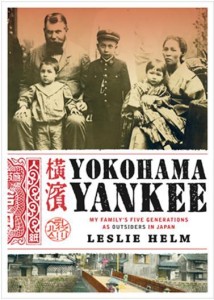
“Yokohama Yankee shows how the events that precede us—the social and political movements, wars, technological advances, and natural disasters—inform our attitudes and behaviors.” (Chin Music Press)
By Michael Glumac (Miyazaki-ken, 2008-09) for JQ magazine. Michael is currently enrolled as a graduate student in international affairs, and has been a music publicist and artist manager.
Pages of Leslie Helm‘s new book Yokohama Yankee seem as though they might be perfectly at place in a Dan Brown novel, and this I mean in the most complimentary manner possible.
Really.
Helm’s non-fiction account of his family’s five generations as outsiders in Japan possess none of the mixed metaphors or historical incongruence so mocked in the Da Vinci Code author’s oeuvre. Portions of Yokohama Yankee, though, where Helm explores remote regions of Japan to uncover the story of his ancestors, possess genuine intrigue surpassing any poorly imagined scuffle with murderous druids.
In an effort to learn about his German great-great-grandfather Julius’s Japanese wife (who once stopped a sword with her bare hands), Helm enlists the help of Buddhist priests to pore over a mountain village temple’s old rice paper scrolls. From the ruins of a Roman aqueduct-like bridge, Helm identifies a mysterious abandoned island off the coast of Kyushu. Here his father engaged in a post-World War II love affair with a woman who had rumored royal connections. His exploration concludes:
“On the way back to the boat we came upon a stone monument about twelve feet high that was all but hidden by shrubs. I held the branches back while the director read the inscription carved into the stone: ‘This is to memorialize the visit of his highness…of the Imperial family.’ The aquarium director looked at me with excitement.”
Feat not, the aquarium director doesn’t turn out to be working for a secret sect of Opus Dei.
JQ Magazine: Book Review – ‘Amorous Woman’

“Amorous Woman is well written—especially the vibrant, vivid sexual acts—and you get the feeling that this would make a great film (If nothing else, there would be some hilarious scenes).” (Iro Books)
By Rashaad Jorden (Yamagata-ken, 2008-2010) for JQ magazine. Rashaad worked at four elementary schools and three junior high schools on JET, and taught a weekly conversion class in Haguro (his village) to adults. He completed the Tokyo Marathon in 2010, and was also a member of a taiko group in Haguro.
If you were to tell stories centering on the most memorable aspects of your stay in Japan, what would you focus on?
Donna George Storey tackled the erotic. Her autobiographic eBook, Amorous Woman, brings out a side of Japan that many might not see. Inspired by Ihara Saikaku’s novel, The Life of an Amorous Woman, Storey brings to life the kinkiest aspects of her nine years in Japan, where she worked as an English teacher and a bar hostess, in addition to enjoying the company (to say the least) of countless Japanese men.
Amorous Woman actually doesn’t start in Japan but in San Francisco, where the novel’s protagonist Lydia is teaching Japanese business etiquette (despite the fact she knows little of it) to businessmen en route to the Land of the Rising Sun. But she’s actually planning to do a 180 from her life in Japan—Lydia has decided to model her life on a Japanese courtesan-turned-nun, a character that only lives in the fantasies of Ihara Saikaku. She even tells herself upon leaving Japan that she will never have sex again.
If only if it weren’t that easy to get the subject off her mind. Since she knows “plenty about picking up strangers in hot spring baths, handcuffing guys to beds in tacky love hotels,” among other things, she decides to tell the real story of her stay in Japan to two students over dinner. That’s when Amorous Woman really heats up.
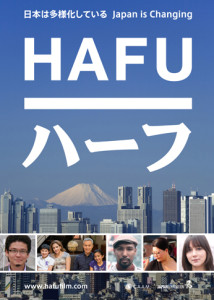
Hafu: The Mixed-Race Experience in Japan premieres in New York July 28. For more information, click here.
By Stacy Smith (Kumamoto-ken CIR, 2000-03) for JQ magazine. Stacy is a professional Japanese writer/interpreter/translator. She starts her day by watching Fujisankei’s newscast in Japanese, and shares some of the interesting tidbits and trends together with her own observations in the periodic series WITLife.
This weekend the annual Asian American International Film Festival will screen the new documentary Hafu: The Mixed-Race Experience in Japan (the title being the Romanization of “half” in Japanese), made by filmmakers Megumi Nishikura and Lara Perez Takagi and. Both half Japanese themselves, these women were inspired to undertake this project due to the lack of media attention on hafus and frustration with the shallow adoration of hafu celebrities on Japanese television.
The film begins with some informative statistics, such as that 2% of Japan’s population is foreign born and a striking 1 out of 49 babies is born to a family with a non-Japanese parent. These numbers have grown greatly over the last 30 years, and yet Japan is still lacking in its understanding of this diverse populace. Hafu features five half Japanese subjects, and their struggles and successes living in Japan today.
One of the families profiled is comprised of a Japanese father and a Mexican mother, who met while studying abroad in the U.S. They later married and now live in Nagoya with their two children. The older one, nine-year-old Alex, is having a hard time at his local school as the other kids tease him for being “English.” Alex’s parents believe that he needs a change in environment and decide to transfer him to an international school. He asks to spend some time in Mexico before the transition, and comes back from this trip brimming with confidence and an easing of the stutter that plagued him when he was being bullied (which his teachers had turned a blind eye to). Alex goes on to love his new school, make friends, and feel comfortable in his own skin without having to worry about being hafu.
Books: An English Language Guide to Crafting in Tokyo
 Interview by Rose Symotiuk (Hokkaido 2003-2005) with Angela Salisbury, author of the Tokyo Craft Guide:
Interview by Rose Symotiuk (Hokkaido 2003-2005) with Angela Salisbury, author of the Tokyo Craft Guide:
As a JET, I keep track of my friends from my Japan days on Facebook. I started seeing posts by my fellow JETs for this cool e-book about crafting in Tokyo. Imagine my surprise when I realized that one of the authors, Angela Salisbury, was an old friend from high school!
I reached out to her to find out more about the book, crafting in Japan, and the JET crafting scene….
Rose: So, how long have you lived in Japan?
Angela: 3 years
Rose: Why did you move to Japan?
Angela: Adventure! The real answer? My husband’s job needed him in Asia, and we decided Tokyo was the place for us.
Rose: Is there an expat crafting scene in Tokyo? If so, can you tell me a little bit about it? Read More
JQ Magazine: Book Review – ‘From Postwar to Postmodern, Art in Japan 1945-1989: Primary Documents’

“What emerges from the multitude of ideas here is that art in Japan from this period is a visual record of repercussions that are still being felt today.” (Duke University Press)
By Jessica Sattell (Fukuoka-ken, 2007-08) for JQ magazine. Jessica is a freelance writer and a graduate student in arts journalism. She was previously the publicist for Japan-focused publishers Stone Bridge Press and Chin Music Press.
The abstract and avant-garde sculptor, painter and all-around revolutionary Japanese artist Tarō Okamoto famously said, “Art is an explostion” (geijutsu wa bakuhatsu da).
“Explosive” barely describes the energy and innovation in Japanese art in the latter half of the twentieth century. As From Postwar to Postmodern, Art in Japan 1945-1989: Primary Documents discusses, the decades between the end of World War II and the end of the Cold War marked an intensely fruitful period of groundbreaking creativity in Japan. The excitement, anxiety, and electricity that surged against the rigidity of old structures propelled Japanese art and artists into a much greater international conversation.
Published earlier this year by the Museum of Modern Art in New York and distributed by Duke University Press, this hefty tome accompanied the fall 2012-winter 2013 MoMA exhibition Tokyo 1955-1970: A New Avant Garde. There’s been a huge wave of both popular and scholarly interest in Japanese modern and contemporary art and dozens of high-profile shows at major North American museums and galleries, but the MoMA exhibit was the first to examine the “postwar” period that had been previously underrepresented. Part of this may be that the term “postwar” is tricky to define; the effects of WWII are undoubtedly still felt today and many argue that Japan is still “postwar.”
This book provides a solid foundation for an exploration of the issues and precedents leading up to the transformation of “postwar” art into the “postmodern” time. But, rather than simply rehash existing scholarship about Japanese history from 1945-1989, the book’s co-editors allow the artists, philosophers, critics and curators of this historical time to speak for themselves. The bulk of From Postwar to Postmodern includes a huge and multifaceted collection of primary source materials—personal essays, artist statements, interviews, magazine articles, interviews, critiques and manifestos—many of which have been translated into English for the very first time.

